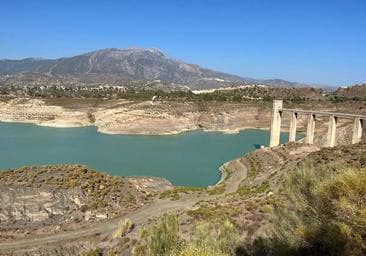Costa del Sol already faces summer with a better guaranteed water supply than last year: here are the figures
The latest data might calm the nerves somewhat, however this is not the moment for flag-waving as Malaga province is far from emerging from drought status
In the last week, the rate of rainwater flowing into Malaga province's reservoirs has started to flatten out after the recen storms. The readings offer interesting figures and the Costa del Sol and inland areas are facing summer with more guarantees of water than last year. This is evident in the Axarquía simply by looking at the level of La Viñuela reservoir, but it is not so evident when looking at the reservoirs along the western coast. However, the hard evidence produced for SUR by trusted experts shows improvements in the supply.
It is key to note that these calculations do not only include a review of the year, but also how the coastal areas face autumn and the following months. Also remember that the hydrological year starts on 1 October. However, this is not the moment for flag-waving as the province is far from emerging from drought status.
The first paradox: never more than 7 months of peace of mind
The first paradox for the Costa del Sol is that it can never have peace of mind for more than seven months ahead given the small size of La Concepción reservoir (only 57 hm3 max capacity). The volume of water in the reservoir was 42.48 hm3 last Thursday. That is 2 hm3 less than last year at the same time, but there are new developments in the pipeline this summer.
Run-off continues to stream in, although it is now falling sharply. According to data from the experts, it is likely that April will end with some 43 hm3 assuming no further rainfall. This is 5.7 hm3 more than the amount forecast for the end of this month in the report presented to the Junta de Andalucía'slast Drought Committee (37.27 hm3). April ended last year with 43.88 hm3.
Some 5.7 hm3 more than that calculated for the last Drought Committee
According to the aforementioned experts, the hydrological year was expected to end, (applying the current limitation set by the Junta of 200 litres per inhabitant per day), with 24.84 hm3 - i.e. moderate drought. This is a little above severe drought (set at 23.5 hm3) and, of course, above extreme drought, established on 1 October 2023 at 19.9 hm3. But we have to add those 5 hm3 of extra rainfall. This would give a final volume for the hydrological year of some 30.54 hm3, which would be almost normal, taking us above moderate drought level, which was set at 27.7 hm3 on 1st October.
The previous hydrological year ended with 20.16 hm3, and there were no restrictions on the coast. With the current limits, the data show 10.38 hm3 more than the previous year.
Desalination plant, wells and Estepona
In addition, thanks to the two-part, urgent action taken by the regional government to increase production at Marbella's desalination plant, the water from there will increase from 150 litres/second output last year to 600 litres/second expected by autumn.
As a side note, at the beginning of the hydrological year La Concepción reservoir has historically averaged a water volume of 30 hm3.
Related article
This is the current state of the reservoirs in Malaga province
To all these volumes must be added the contributions from the Guadalmansa (Estepona) and Fuengirola wells and new sources of supply. Despite not making a huge impact on the final total, they do add up - for instance, as in the first phase of desalination production in Estepona. Estimates from Estepona town hall and Hidralia (the company handling the downstream supply) point to some 2,000 m3 per day from the brackish wells of Padrón and some 8,000 m3 if installation of the mobile seawater desalination plant is successfully completed.
Total water reserves in the province are 170.05 hm3 (215.41 last year). This is 73 more than at the beginning of March
This year there are no plans to purchase any volume from Arcgisa (a water and waste water company based in Campo de Gibraltar), according to the forecasts made by Acosol for the last Drought Committee meeting. The committee will reconvene for an update on the water situation at the end of May or early June, finalising any adjustments for summer and preparations for autumn. A further decision will be taken there as to whether to relax current restrictions or whether to maintain the daily quota of 200 litres per inhabitant.
The Axarquía and Malaga city
In the Axarquía, the analysis is more straghtforward. The reservoir contained 31.27 hm3 by 5pm last Thursday compared to 16.46 hm3 last year. In fact, although irrigation with reservoir water remains suspended, the transfer of 270 litres per second from Malaga city is on hold and the water coming from Chíllar river continues to enter. Nevertheless, the Axarquia remains poised at the threshold of severe drought.
Malaga city is expected to return to severe drought after the summer. Comparatively, the situation is much worse than last year but, given its highly diversified reserves, it has enough water for a year and a half. It should be remembered that, in June, another 200 litres per second will be added from the Aljaima and Fahala wells; then, in autumn, the first wells in the Bajo Guadalhorce river basin are expected to be brought back into use.
Last Thursday the total water volume in the Guadalteba, Guadalhorce and Conde de Guadalhorce reservoirs was 85.23 hm3, 14 hm3 above the serious drought threshold, but rainfall is now very low compared to last year when they totalled 136.25 hm3.
Total reserves in the province are 170.05 hm3 (215.41 last year). This is 73 hm3 more than at the beginning of March.


